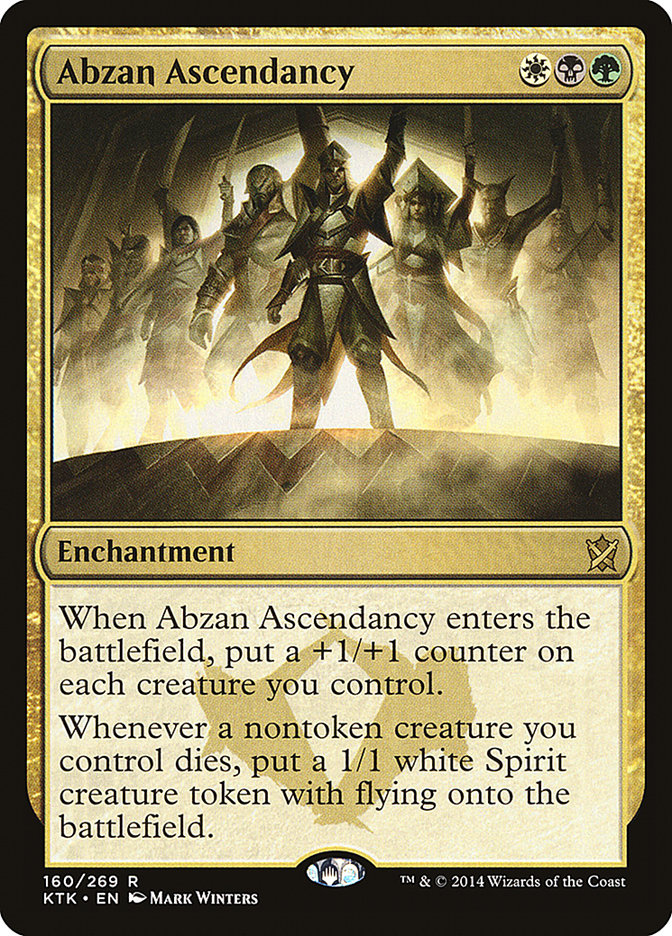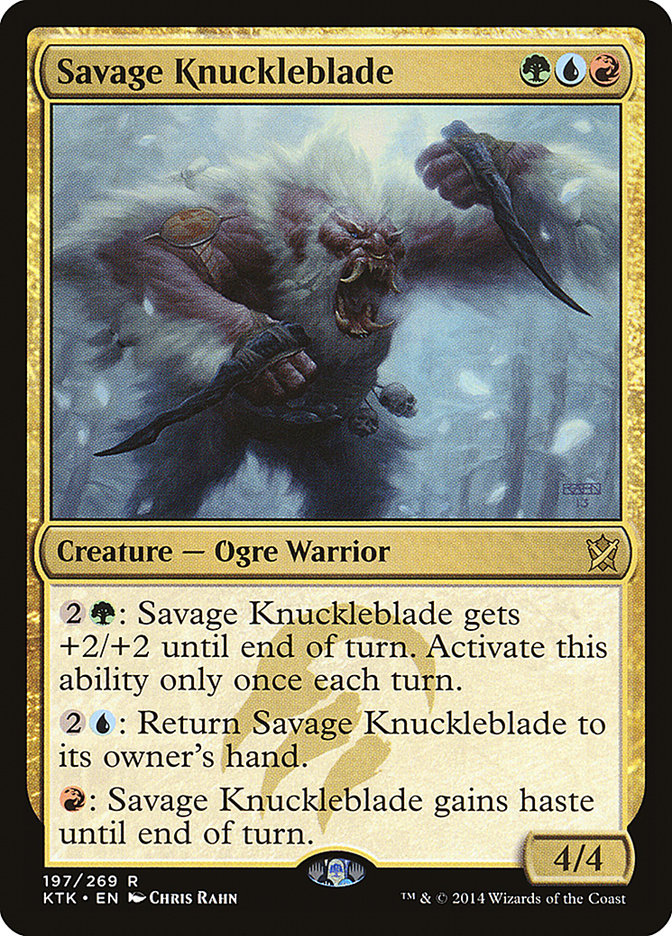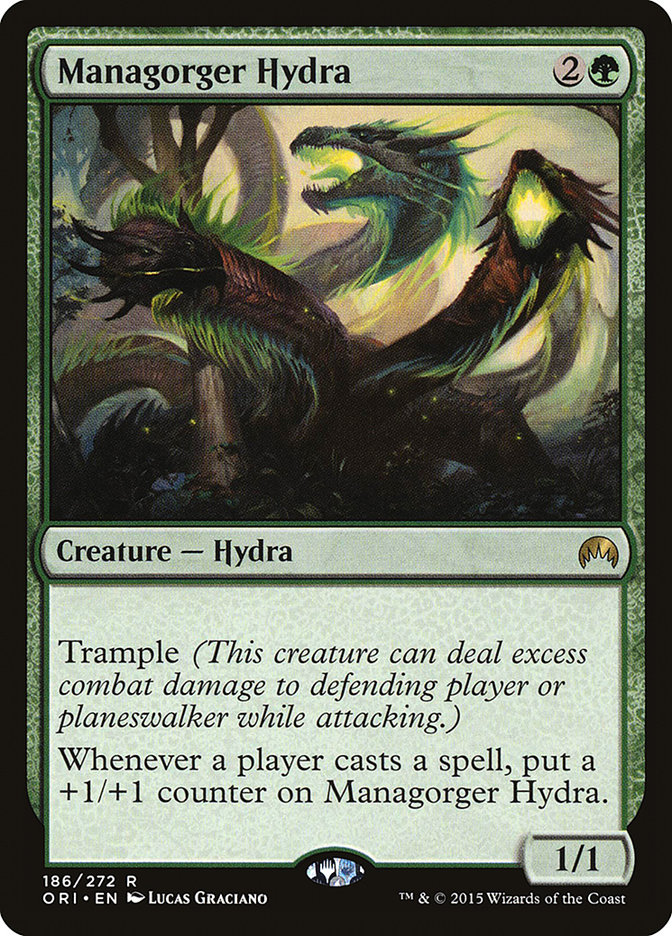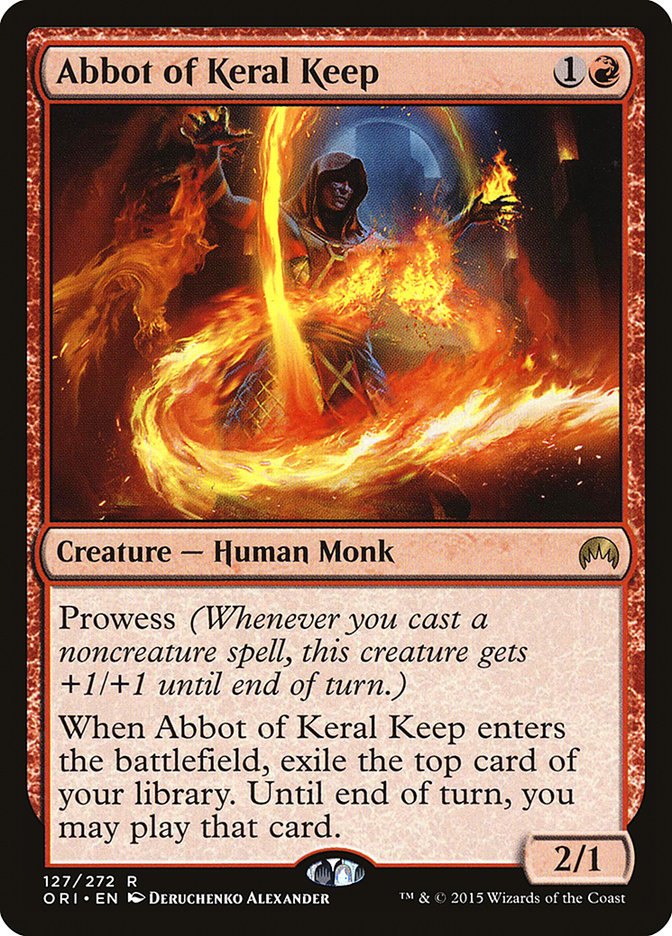I’m probably wrong about Battle for Zendikar. Last week, I wrote about how the Battle lands were the only
cards I was really excited about playing. Hangarback Walker seems like it fits into every midrange shell, but it may be that we’re just being lazy. There
is some obvious synergy with cards like Blisterpod and Bone Splinters (and Hangarback Walker), but I don’t know if it can compete with the likes of Siege
Rhino or Gideon, Ally of Zendikar. Standalone cards that are powerful without any help have so much value in a format like Standard, because most decks are
bottle-necked into playing a ton of removal spells. When nearly every deck is creature-based, playing a lot of removal seems like a great idea.
So why does it feel so bad to cast Blisterpod?
The new Blood Artist (Zulaport Cutthroat) seems like it should be great in the deck, but I’m not convinced. Blood Artist was particularly powerful because
you could sit on removal spells for your opponent’s creatures, draining their life all the while. You also didn’t mind trading in combat, or just
gang-blocking their biggest creature. At the end of the exchange, they would be down a few life points from where they started, and you would likely be up.
The exchange of one additional power from Zulaport Cutthroat for losing the ability to drain when your opponent’s creature dies is a pretty big downer. In
all honesty, that’s how I’ve been feeling about the entirety of Battle for Zendikar. Nothing stands out. Everything feels watered down. So many
different cards seem like they could have potentially been great, or at least interesting. Instead, I get the feeling that they were afraid to make
anything too good. And fear is always the death knell.
I could write an entire article on how a few small tweaks to some of the cards could have made this set awesome. But I’m not a card designer, so I’m
willing to be wrong, because being wrong just means that the format is great. Even if the format is just Khans of Tarkir block, Magic Origins, and some new lands from Battle for Zendikar, it will still probably be fun. Khans block gave us a lot of great tools to
work with, and Magic Origins was pretty good, even though most people thought it looked pretty bad. Battle for Zendikar might just end up
being a lot like Magic Origins, where most people were fairly unhappy with the set at first glance, but the set turned out to be great.
New cards are tricky to evaluate, and especially so when we have so little context about where the cards need to fit. Look at these, for example.
We have seen “Aristocrat” decks in the past, but does that sort of strategy still work? Are these new cards good enough to warrant an entire deck being
built around them? We keep telling each other that Hangarback Walker is good, but it would be great if you had a lot of sacrifice outlets. Well, we have
the ability to play Altar’s Reap, Bone Splinters, and Nantuko Husk. All of those cards seem like they would fit perfectly together. The real question here
is can this deck close games?
I’m not sold on Rot Shambler or Zulaport Cutthroat, but most cards built around synergistic strategies start off looking pretty miserable. I mean, the old
Aristocrats deck played Young Wolf. When I first saw the deck, Young Wolf was the card I wanted to cut the most, but at one point I ended up playing the
full four Young Wolf alongside Doomed Traveler, and I still don’t know which one is better.
At this point, we all know (or at least think we know) that Blisterpod is good. I think Carrier Thrall is also fine, albeit a little more expensive without
adding much. You want sticky creatures (effects that create more creatures when they die) in a deck like this, so redundancy is useful in its own way. I
likely wouldn’t load up on them, but they are still a necessary evil. On the other hand, both Zulaport Cutthroat and Rot Shambler will need to impress me
quickly before I cut them from the shell completely.
A deck like this might also want Collected Company. I’m not sold on it being great, but it is a solid value card that could put just about any of your
engine cards onto the battlefield (aside from Hangarback Walker), while also just providing you with something to do with mana in the later turns of the
game.
The manabases created from the Battle lands might also allow for splashing a fourth color quite easily. I think something like Butcher of the Horde could
be a phenomenal finisher in a deck like this. But how do we put it all together? How do we fit every piece, or the right pieces, into the deck? It will
take a bit of testing, but I think we could eventually find the right set of spells for a new Aristocrats archetype, which has me very excited.
The rough draft.
Creatures (22)
Planeswalkers (4)
Lands (24)
Spells (10)

I played this deck in a VS Video that should go up next week before the inaugural Standard Open in Indianapolis. My initial thoughts:
–Zulaport Cutthroat is likely better than I give him credit for. I ended up trimming and eventually cutting all of them after a few games. In the matchup
we played, it didn’t seem like it was all that great, but I think the card itself might just be bad. I don’t know for sure, but I felt like losing the
element of triggering on your opponent’s dying creatures was very mediocre.
–Abzan Ascendancy was slow, and you probably want a few more cheap creatures in the deck to make it great. You probably also want another sacrifice outlet,
like Butcher of the Horde, to keep turning your dorks into Spirits. Abzan Ascendancy is a great card with Nantuko Husk, as it makes nearly every attack
into a potential lethal one, and you’re usually able to trade away one creature and the subsequent Spirit token to kill their blocker. Abzan Ascendancy
makes you much stronger against sweeper effects, and even makes Dragonlord Atarka less painful, which is great for a deck featuring a ton of low-toughness
creatures.
–Catacomb Sifter didn’t impress me, but it wasn’t exactly bad. I think that, if there is a shell for it to be good in, this would be the one. Since it
didn’t shine and I drew it a reasonable amount, I think it is safe to conclude that it isn’t good enough. You want a ton of cheap creatures that make Abzan
Ascendancy better or creatures you can put on the battlefield before you cast Nantuko Husk.
–Evolutionary Leap seems like it could potentially find its way into the maindeck (as I talk about in the video), but it mostly shines against
heavy-removal strategies. Most of your creatures create an additional creature when they die, so you go “infinite” with Evolutionary Leap. It is likely too
slow for the beginning of the format, but if “Abzan Good Stuff” decks keep ruling the roost, Evolutionary Leap is probably awesome.
–Bone Splinters is the real deal. It didn’t see much play (if any) in the previous Standard format it was in, but that was a world where Tragic Slip
existed alongside a lot of sacrifice outlets. In this world, we need a cheap removal spell to blow up Dragonlords and Rhinos. Bone Splinters also makes
your Hangarback Walkers absurd since all you want to do is grow them and then find a way to sacrifice them. Bone Splinters looks really bad on paper, but
it felt like the best card in the whole deck.
–Gideon, Ally of Zendikar is a glorified anthem in this deck, but he is versatile enough to deserve the heavy white splash. I think that the manabase is
off a bit to support him fully, but if we end up splashing another color, we get Wooded Foothills to act as the best land possible. Evolving Wilds can also
help us find all of our early basic lands, which will in turn make our dual lands great in the lategame. In this version, your lands are a bit clunky, as
Shambling Vent and Sandsteppe Citadel enter the battlefield tapped, but both were necessary to make Gideon a castable card. It is shocking to me to find
out that four-color manabases are consistently feeling better than three-color ones.
-I’m not sure if Abzan Charm is the right card for this deck, but it is certainly one of the best cards in Standard at the moment. It would be awkward not to play it. The trick with this style of deck is making sure you have enough creatures, and don’t overload on removal. A few copies of Abzan
Charm is likely fine, but I’m not sure if the right number is two, three, or four. If we cut Zulaport Cutthroat and Catacomb Sifter, that leaves a lot of
room to work with, but those slots probably need to be creatures.
–Rally the Ancestors could be a viable card in this type of strategy. You can “burn” people out with Zulaport Cutthroat and Nantuko Husk, but the major
problem here is that we don’t have a way to give those creatures haste without Mogis’s Marauder. It is possible that the value-centric version of Rally the
Ancestors is great, featuring Merciless Executioner, Fleshbag Marauder, and Liliana, Heretical Healer. But if you’re playing those cards, I’m not sure you
want to be playing the rest of the Aristocrats shell. I also have no idea how to build this kind of deck.
…
One mechanic that I want to reexamine is landfall. The creatures look worse than Plated Geopede and Steppe Lynx at first glance, but maybe they’re still
good enough. After playing some with the landfall creatures, I noticed that you wanted to hit your land drop almost every single turn (shocker, I know).
Most aggressive decks don’t want to do that because flooding is a real issue. So how do we mitigate that?
Cards like Savage Knuckleblade could be an easy splash in a Naya build since you already want to play a ton of fetchlands and possibly even Evolving Wilds.
Wilds was a staple in the old-school R/W Landfall decks, and I don’t think it will be any different here. The major difference between the current version
and the older versions is that we could stumble on our mana early if we play too many Battle lands. With Evolving Wilds and fetchlands, it isn’t hard to
have enough basic lands to make the Battle lands enter the battlefield untapped, but you rarely want to draw a Battle land in the first two turns.
After tinkering a bit with the deck, here’s a list I’d be pretty happy starting with.
Creatures (24)
- 4 Savage Knuckleblade
- 4 Managorger Hydra
- 4 Abbot of Keral Keep
- 4 Scythe Leopard
- 4 Makindi Sliderunner
- 4 Snapping Gnarlid
Lands (25)
Spells (11)
Sideboard

The first thing I noticed was how easy it was to delve. I wanted to play Treasure Cruise, but common sense tells me that Treasure Cruise is mediocre in a
deck without a ton of cheap instants and sorceries. Instead, I want to just kill them, and you can do that pretty easily with Become Immense after a few
attacks from your landfall creatures.
Savage Knuckleblade and Managorger Hydra aren’t exactly exciting to me, but I wanted some big creatures in the three-drop slot. With Dromoka’s Command,
Atarka’s Command, and Become Immense in your spell suite, Managorger Hydra seems pretty awesome. The trampling bit could lead to some blowouts with Become
Immense (as well as Sliderunner), but it will likely be attacking for four or more if you get to untap. The sideboard Temur Battle Rage seem pretty
disgusting with Managorger Hydra, assuming your opponent is trying to goldfish.
Abbot of Keral Keep is a great creature. As you can see in this deck, we actually want to hit a land with it, where most decks want to hit a spell. We
can’t trigger prowess too often, but it is another two-drop that works great with your manabase. And the games where you get a redraw to hit Atarka’s
Command or Become Immense to kill them from nowhere, you’ll understand how many roles he can play in the deck. Abbot can also put two counters on
Managorger Hydra, which is pretty nice.
The lack of removal in this deck could be problematic, but we don’t have access to much. Instead of Savage Knuckleblade and blue, we could splash black for
Murderous Cut and/or Crackling Doom. In that scenario, our creature base is likely worse, and Forest is actually a pretty bad land to see in the earlygame.
When building a four-color manabase, I think you need to make sure your big splash color can be cast off your primary land. In this case, Mountain and
Forest are our primaries, so I don’t want to splash a color (or spells) that can’t be cast from those. Exceptions can be made if we add a four-drop like
Siege Rhino, but in that scenario I think I might just prefer playing Abzan splashing Crackling Doom (which actually sounds great).
At the moment, virtually anything is possible in Standard. You just need to make sure that your lands can support your spells. If your spells and lands
don’t really match, you’ll end up stumbling too often and likely just lose because of it. If you have any spells that cost one or two mana, make sure your
basic lands support that. If you want to play three-drop spells that don’t match those two basic lands, you probably shouldn’t.
With the Naya Landfall deck, I tried to do just that. The question is whether or not these cards are actually worth splashing. At its heart, it is just a
G/R Aggro deck that decided to jam Dromoka’s Command and Savage Knuckleblade. I think the mana will be smooth enough to support it, but drawing either
Island or Plains in the early turns isn’t great. There isn’t a lot you can do to mitigate this other than playing spells with a healthy amount of colorless
symbols on them. With Managorger Hydra and all of the two-drop creatures featuring a colorless symbol, I think it should be fine.
So far in testing, this Standard format has had by far the most difficult sequencing of lands. I regularly don’t know which lands to fetch, and in what
order, to cast my spells on time. Building these manabases will be pretty difficult, but playing with them will also take some time to get used to (much
like the Temples from Theros block). This is the first time we’ve had fetches and dual lands in the same Standard format. The fact that we don’t
have all ten dual lands means we’re going to have some trouble adjusting, but I’m confident we’ll all figure it out in a few weeks.
All in all, I’m excited to start playing Battle for Zendikar Standard. Theros was a great block, and led to a fun Standard format. At
times, it was a bit stale, but each set opened up new possibilities. I don’t think Battle for Zendikar is any different. Some cards will be great,
and some will be underrated at first. And like every set, some cards will be overrated. In time, this Standard format will flesh itself out, and people
will be pleasantly surprised that it is pretty fun getting to play whatever spells you want. Three- and four-color decks (and maybe even five- color decks)
will be major players until Khans of Tarkir rotates out of Standard.
And if you’re getting frustrated trying to come up with new ideas (like me), just remember that you can still cast Siege Rhino, Mantis Rider, and Jeskai
Ascendancy. We have a lot of tools to work with from Khans block. Now we have great mana to tie everything together.








